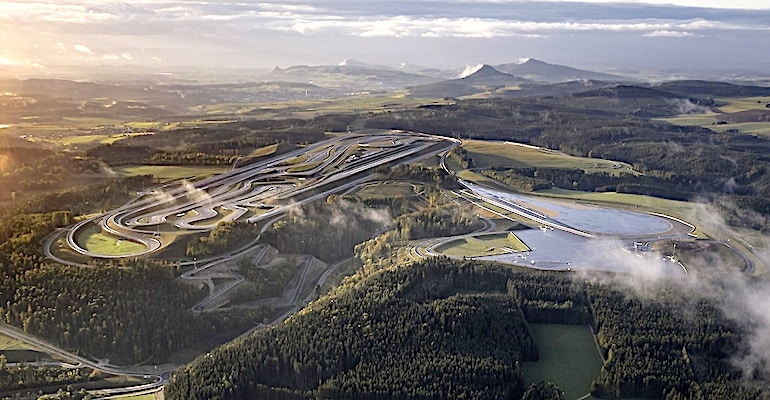
Mercedes Immendingen Proving Grounds: Where the Technological Magic Happens

“It really is a perfect place for engineers,” obverved Mercedes-Benz electric drive special projects engineer Julien Pillas as we toured the Immendingen Testing and Technology Center. It lies in the foothills of the Swiss Alps, about 80 miles south of the company’s Stuttgart headquarters, almost at the Swiss border.
The 1,300-acre plot of land was the home of the German Army’s 292nd Panzer Grenadier Battalion during the Cold War. But as that seemingly wound down, the battalion moved out and Mercedes moved in.
The company spent more than $200 million converting the former war game zone into a facsimile of various kinds of driving environments with 43 miles of roads. These include a variety of different driving conditions such as long-distance journeys, off-road circuits, hilly terrain, braking tracks, or urban circuits, which means many prototype test drives have been moved from the public streets to the test center in Immendingen. There is even a section with 30 huge fans to test vehicles in strong cross wind conditions.
The high-speed oval is similar to the ones at other test tracks, with parabolic banking that lets cars run a top speed all the way around the oval for high-speed endurance tests. Mercedes employed the oval track to create an artificial traffic jam so that I could experience the company’s SAE Level 3 driver assistance system in the EQS EV. Regular roads twist through the hilly terrain, making driving on them indistinguishable from driving on the rural roads outside the test center.
Having all these conditions in one location and conveniently near the engineers’ on-site offices explains why Pillas is so happy to have access to such a facility for vehicle development.
Mercedes describes this specific portion of the proving grounds:
- Rough Road Circuit The 13-feet wide rough road circuit more or less follows the perimeter of the test site and is 7.1km long in total. The gradients range between 15 percent and 20 percent.
- Bertha Area At a million square feet, the Bertha area is the largest asphalt area after the driving dynamics area. In German, Bertha stands for “Bereich zum Erproben und Testen von und mit hochautomatisierten Fahrzeugen” (Area for testing highly automated vehicles). The 3,110-foot long and in some places 2,130-foot wide area is used to test driver assistance systems and autonomous vehicles. Among other things, the Bertha area offers the opportunity to test safety-relevant scenarios at highway speeds or merging or lane-changing scenarios, and to check collision avoidance functions in linear and cross-traffic.
- 4×4 Module The 4×4 module is a semi-natural test site with a sharply contrasting topography and a network of unpaved roads and open fields for testing and developing all-wheel drive and all-terrain vehicles. The module has two inclines with 40 percent and 70 percent gradients over a distance of 100 feet.
- Jura Endurance Course The Jura endurance course simulates the test track’s surrounding German Alpine terrain with its three courses of steep slopes that allow testing under real-world conditions.
- Technology Center All functions necessary for the testing process are carried out in the Technology Centre. The former barracks have been converted into workspaces for the company’s 300 employees from Research and Development, Logistics and Warehousing, as well as all functions relating to the maintenance of the vehicles (workshops, tire center, fuel station, electric vehicle charging stations).
- City Quarter The city quarter consists of more than a mile of city streets with various intersections. These are used to test driver assistance systems, Car-to-X communication, and autonomous driving under real-world conditions. This makes it possible, for example, to simulate how autonomous vehicles communicate with one another to ensure the safety of vehicles in a city.
- Handling Circuit The winding 3-mile asphalt track lies inside the oval circuit. Owing to its altitude profile, the handling circuit resembles the Nürburgring. It is used to simulate longitudinal and lateral acceleration in order to assess the tires and the vehicle handling. Everyday and unforeseen emergency scenarios are reconstructed, such as sudden obstructions on the highway.
- Oval Circuit The oval circuit is the centerpiece of the Test Center. The banked curves of the 4km course can be driven at a specified speed without steering. This “endless straight line” circuit simulates highway driving – important for the development of autonomous vehicle handling.
- Rough Road Test Track The rough road test track is a winding circuit resembling a country road with a special gravel surface made of limestone marl and limestone grit. Dirt gets into all the cracks and crevices of the vehicles, from the axle bearings or axle joints to the bodywork. This results in conclusions and measures for the vehicles’ daily use.

Leave a Reply